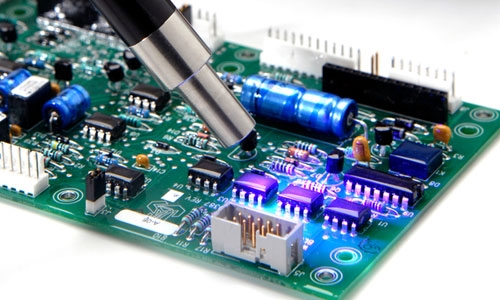Dymax Light Guides for UV/LED Light-Curing Spot Lamps
Light guides are essential in transmitting light energy generated from UV/LED spot curing systems to targeted areas and directing that light precisely where needed, which is critical for curing adhesives and coatings efficiently. Their design and functionality make them an economical choice for delivering energy essential for curing processes and play a crucial role in the manufacturing and assembly of various components.
When comparing liquid-filled versus quartz-fiber optic light guides, it's essential to consider the specific requirements of the curing application.
Regarding cost and performance, liquid light guides provide significant savings and higher-intensity transmission, making them versatile for various curing applications. However, their suitability is limited for tasks requiring shorter wavelength transmissions and their performance in high-temperature conditions.
While more expensive, quartz-fiber light guides provide better suitability for unfiltered UVB/UVC/IR intensity applications. Their design eliminates the need for active balancing in multi-pole configurations, offering ease of use and consistency in multi-point curing applications.
Key Advantages of Using Light Guides
Economic Efficiency: Light guides offer a cost-effective means to direct curing energy precisely, minimizing waste and optimizing the curing process.
Enhanced Precision: The ability to transmit energy directly to the required spot ensures high-quality curing outcomes, essential for the integrity of assembled parts.
Versatility: The availability of different types of light guides and accessories allows engineers to select the most suitable one based on their curing process requirements.
液芯光导管
Liquid light guides are notable for their cost-effectiveness and are often priced less than half that of quartz-fiber alternatives. This affordability does not come at the expense of performance; in single-pole configurations, liquid light guides transmit 35-50% more intensity across all system types than quartz-fiber ones. The core of these guides contains a proprietary, non-toxic saline solution, which plays a crucial role in their ability to transmit a high intensity of curing energy. Extended-range liquid light guides that cater to specific needs in demanding scenarios are available.
However, liquid light guides have their limitations. They are unsuitable for applications requiring UVB or UVC spectral energy transmission and are a poor fit in high-temperature environments. When utilized in multi-pole configurations, liquid light guides necessitate active balancing to ensure uniform energy distribution across all poles. Liquid light guides also degrade with use and are consumables that eventually need to be replaced. The initial cost may be lower, but the total lifetime cost can be higher in a service that heavily taxes the light guide. Systems that use liquid light guides may also need more frequent adjustments to stay within the parameters of a process.
Quartz-Fiber Light Guides
The construction of quartz-fiber light guides encompasses a randomized bundle of quartz fibers, which inherently possess excellent spectral transmission characteristics. This assembly makes them particularly well-suited for applications requiring the delivery of shorter wavelength energy, such as those needed to counteract O2 inhibition or surface tack issues in certain adhesive formulations.
One of the technical drawbacks of quartz-fiber light guides is their lower numerical aperture compared to liquid light guides. This characteristic reduces efficiency in capturing energy from the wide emitting angles typical of LED systems, leading to a lower intensity of transmitted energy. They also have significantly longer lifetimes and much lower rates of performance decay. Processes can be much more stable with fiber optic lightguides, and they offer a significant advantage in multi-pole configurations as they do not require active balancing, simplifying their setup and use.
The choice between liquid light guides and quartz-fiber light guides for UV/LED light-curing spot lamps is pivotal, with each type offering distinct advantages based on their construction and material properties.
Get more details in the Dymax Light Guides & Accessories Technical Bulletin.

